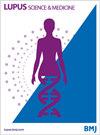Mezagitamab in systemic lupus erythematosus: clinical and mechanistic findings of CD38 inhibition in an autoimmune disease
IF 3.7
2区 医学
Q1 RHEUMATOLOGY
引用次数: 0
Abstract
Objective To evaluate safety and mechanism of action of mezagitamab (TAK-079), an anti-CD38 monoclonal antibody, in patients with moderate to severe systemic lupus erythematosus (SLE). Methods A phase 1b double-blind, placebo-controlled, multicentre study was conducted in patients with SLE receiving standard background therapy. Eligible patients were adults who met the 2012 SLICC or ACR criteria for diagnosis, had a baseline SLE Disease Activity Index 2000 (SLEDAI-2K) score of ≥6 and were positive for anti-double-stranded DNA antibodies and/or anti-extractable nuclear antigens antibodies. Patients received 45 mg, 90 mg or 135 mg of mezagitamab or placebo every 3 weeks over 12 weeks. Primary endpoints were safety and tolerability. Secondary endpoints included pharmacokinetics and pharmacodynamics. Exploratory assessments included disease activity scales, deep immune profiling and interferon pathway analysis. Results 22 patients received at least one dose of either mezagitamab or placebo. In patients exposed to mezagitamab (n=17), drug was well tolerated. Adverse event (AEs) were balanced across treatment groups, with no treatment emergent AEs exceeding grade 2. Responder analyses for Cutaneous Lupus Erythematosus Disease Area and Severity Index (CLASI) and SLEDAI-2K did not reveal any observable differences across treatment groups. However, there was a trend for more profound skin responses among patients with higher CLASI scores (>10) at baseline. Pharmacodynamic analysis showed median CD38 receptor occupancy up to 88.4% on CD38+ natural killer cells with concurrent depletion of these cells up to 90% in the 135 mg group. Mean reductions in IgG and autoantibodies were less than 20% in all dose groups. Cytometry by time of flight and type 1 interferon gene analysis revealed unique fingerprints that are indicative of a broad immune landscape shift following CD38 targeting. Conclusions Mezagitamab had a favourable safety profile in patients with moderate to severe SLE and elicited a pharmacodynamic effect consistent with CD38+ cell depletion. These findings reveal novel insights into the drug’s mechanism of action and support the continued investigation of mezagitamab in autoimmune diseases. Data are available upon reasonable request. The datasets, including the redacted study protocol, redacted statistical analysis plan, and individual participants data supporting the results reported in this article, will be made available within three months from initial request, to researchers who provide a methodologically sound proposal. The data will be provided after its de-identification, in compliance with applicable privacy laws, data protection and requirements for consent and anonymisation.美扎吉单抗在系统性红斑狼疮中的应用:在自身免疫性疾病中抑制 CD38 的临床和机理研究结果
目的 评估抗CD38单克隆抗体mezagitamab(TAK-079)在中重度系统性红斑狼疮(SLE)患者中的安全性和作用机制。方法 在接受标准背景疗法的系统性红斑狼疮患者中开展了一项1b期双盲、安慰剂对照多中心研究。符合条件的患者均为符合2012 SLICC或ACR诊断标准、系统性红斑狼疮疾病活动指数2000(SLEDAI-2K)基线评分≥6分、抗双链DNA抗体和/或抗可提取核抗原抗体阳性的成年患者。患者每3周接受45毫克、90毫克或135毫克的mezagitamab或安慰剂治疗,共12周。主要终点是安全性和耐受性。次要终点包括药代动力学和药效学。探索性评估包括疾病活动量表、深度免疫分析和干扰素通路分析。结果 22名患者至少接受了一次麦扎吉单抗或安慰剂治疗。接受麦扎吉单抗治疗的患者(17人)耐受性良好。各治疗组的不良事件(AEs)分布均衡,没有出现超过2级的治疗突发AEs。皮肤红斑狼疮疾病面积和严重程度指数(CLASI)和SLEDAI-2K的应答者分析显示,各治疗组之间没有任何明显差异。不过,基线时CLASI评分较高(大于10分)的患者的皮肤反应有加深的趋势。药效学分析表明,CD38+ 自然杀伤细胞的 CD38 受体占用率中位数高达 88.4%,135 毫克组中这些细胞的同时耗竭率高达 90%。在所有剂量组中,IgG 和自身抗体的平均降低率均低于 20%。通过飞行时间和 1 型干扰素基因分析进行的细胞测定显示出独特的指纹,表明 CD38 靶向后免疫格局发生了广泛的变化。结论 Mezagitamab 对中重度系统性红斑狼疮患者具有良好的安全性,并产生了与 CD38+ 细胞耗竭一致的药效学效应。这些发现揭示了药物作用机制的新见解,支持继续研究美扎吉单抗在自身免疫性疾病中的作用。如有合理要求,可提供数据。数据集(包括经编辑的研究方案、经编辑的统计分析计划以及支持本文所报道结果的参与者个人数据)将在首次申请后三个月内提供给提出合理方法建议的研究人员。这些数据将根据适用的隐私法、数据保护以及同意和匿名化要求进行去标识化处理后提供。
本文章由计算机程序翻译,如有差异,请以英文原文为准。
求助全文
约1分钟内获得全文
求助全文
来源期刊

Lupus Science & Medicine
RHEUMATOLOGY-
CiteScore
5.30
自引率
7.70%
发文量
88
审稿时长
15 weeks
期刊介绍:
Lupus Science & Medicine is a global, peer reviewed, open access online journal that provides a central point for publication of basic, clinical, translational, and epidemiological studies of all aspects of lupus and related diseases. It is the first lupus-specific open access journal in the world and was developed in response to the need for a barrier-free forum for publication of groundbreaking studies in lupus. The journal publishes research on lupus from fields including, but not limited to: rheumatology, dermatology, nephrology, immunology, pediatrics, cardiology, hepatology, pulmonology, obstetrics and gynecology, and psychiatry.
 求助内容:
求助内容: 应助结果提醒方式:
应助结果提醒方式:


